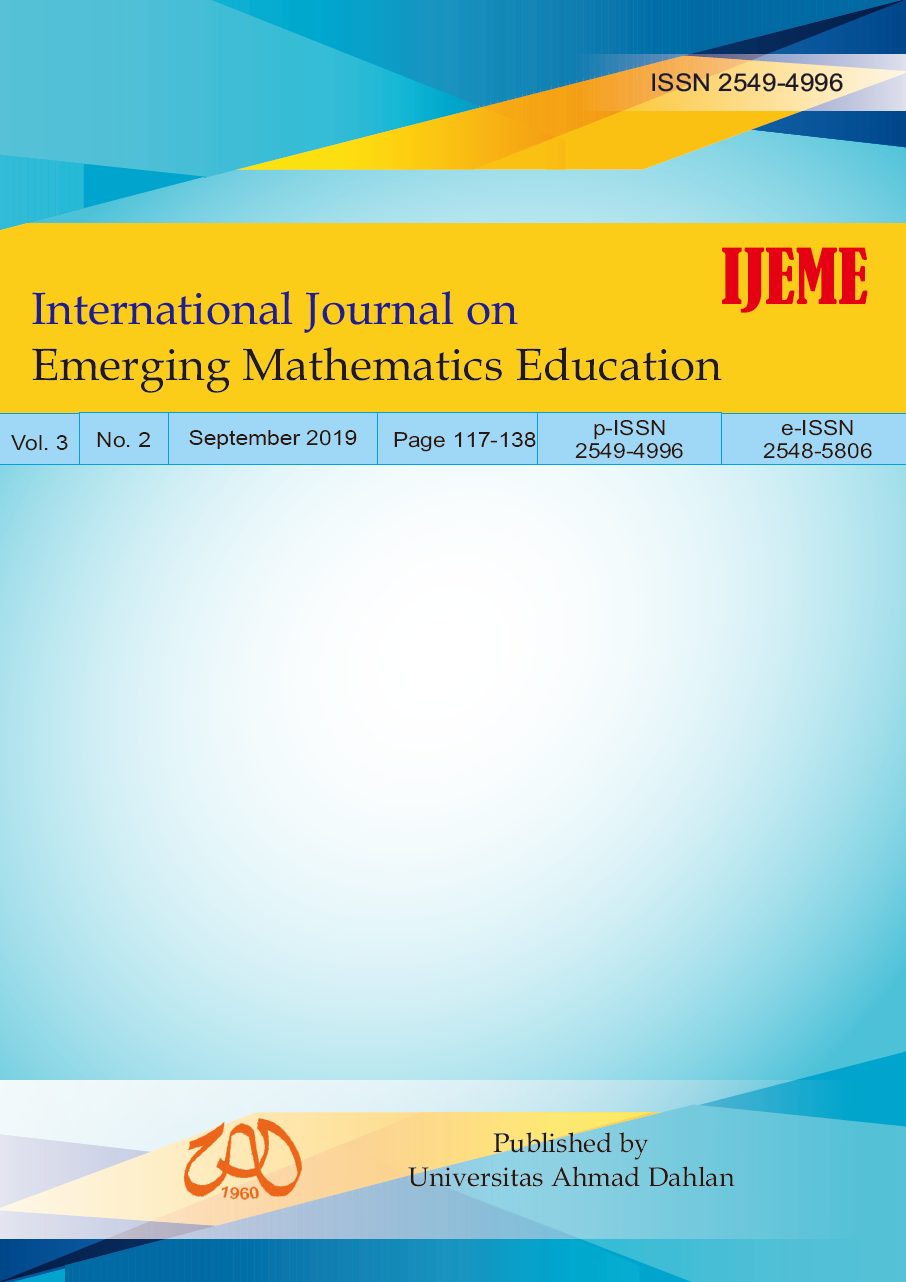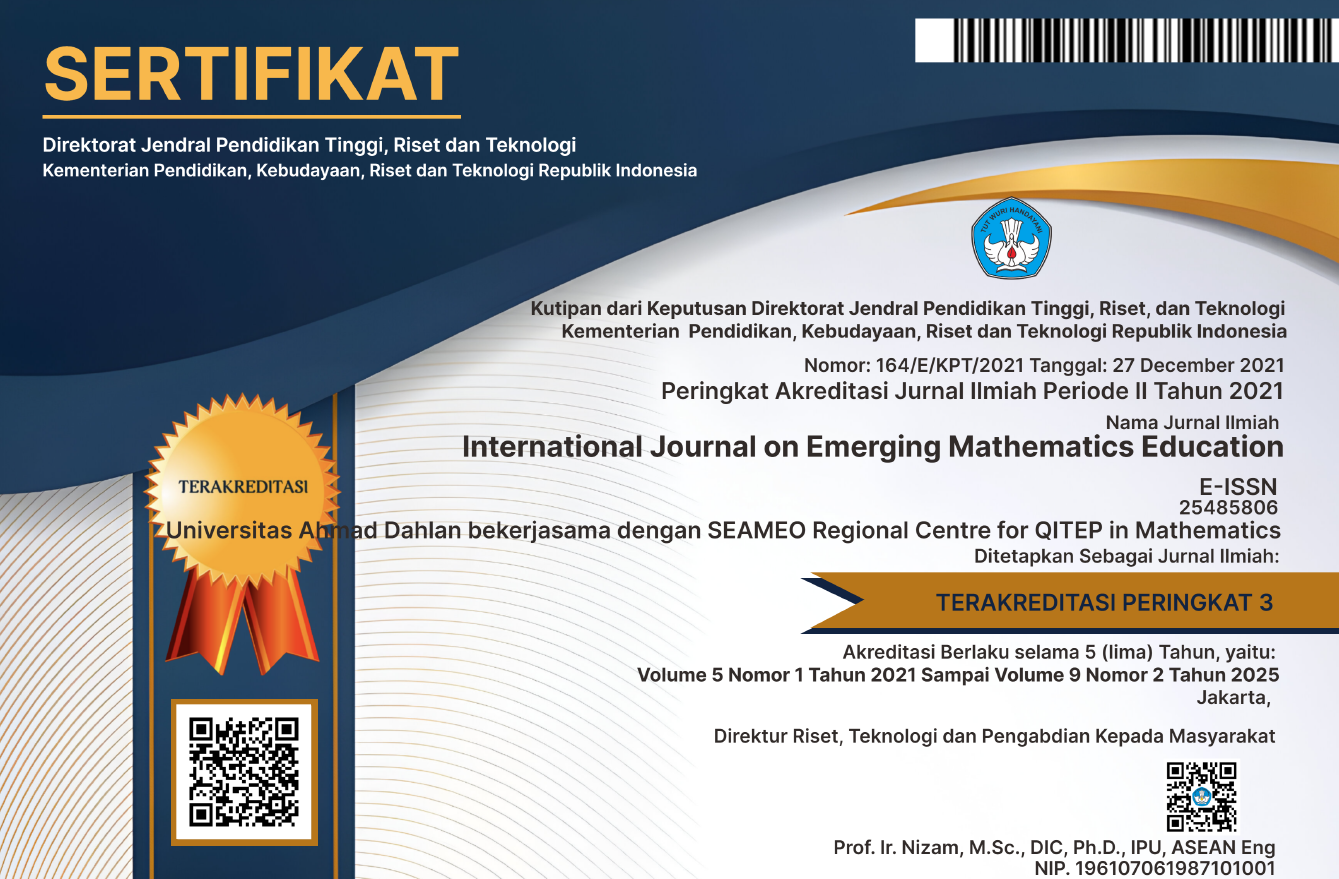Analysis of Difficulty of Student’s Geometry Problem Solving Based on Van Hiele’s Thinking Theory with Macromedia Flash
DOI:
https://doi.org/10.12928/ijeme.v3i2.13658Keywords:
Difficulties, Problem Solving, Geometry, Van Hiele Thinking Theory, Macromedia FlashAbstract
This study aims to describe the level of students' geometry thinking based on Van Hiele's thinking theory, the level of students' geometric problem solving abilities, and analyzing students' difficulties in solving geometric problems. This type of research is qualitative descriptive research. The researcher took six research subjects consisting of low, medium, and high level geometry problem solving abilities to be interviewed and analyzed the types of difficulties experienced. The results of this study indicate that there are 26 students reaching level 0 (visualization), 21 students reach level 1 (analysis), 13 students reach level 2 (informal deduction), 6 students reach level 3 (deduction) and no one can reach level 4 (rigor). Furthermore, there are 13 students who have a low level of problem solving ability, 7 students have a medium level of problem solving ability, and 6 students have a high level of problem solving ability. The difficulties experienced by the research subject are described in each problem.
References
Abdussakir. 2010. Pembelajaran Geometri Sesuai Teori van Hiele. El-Hikmah Jurnal Kependidikan dan Keagamaan, 7(2), ISSN 1693-1499.
Adolphus, T. 2011. Problems of Teaching and Learning of Geometry in Secondary Schools in Rivers State Nigeria. International Journal of Emerging Sciences. 1 (2): 143-152.
Burger, W.F, Shaughnessy, J. M. 1986. Characterizing the van Hiele Levels of Development in Geometry. Journal for Research in Mathematics Education. 17(I):31-48.
Darmana, I. K. R., Sedanayasa, G., Antari, N. N. M. 2013. Pengaruh Model Problem-Based Instruction Terhadap Kemampuan Pemecahan Masalah Dalam Pembelajaran matematika. Mimbar PGSD, 1.
Krismiati, A. 2013. Penerapan Pembelajaran Dengan Pendidikan Matematika Realistik (PMR) Secara Berkelompok Untuk Meningkatkan Kemampuan Pemecahan Masalah Matematis Siswa Di Kelas X SMA. Jurnal Infinity, 2(2), 123-135
Mulyana, E. 2003. Masalah Ketidaktepatan Istilah Dan Simbol Dalam Geometri SLTP
Kelas 1. Dalam file.upi.edu/…ENDANG MULYANA/Psikologi_geometri. Diakses 1 Maret 2013.
Muhassanah, Sujadi, Riyadi. 2014. Analisis Keterampilan Geometri Siswa Dalam Memecahkan Masalah Geometri Berdasarkan Tingkat Berpikir Van Hiele. Jurnal Elektronik Pembelajaran Matematika. Vol.2, No.1, hal 54 - 66, Maret.
OECD. 2016. PISA 2015 Assesment and Analytical Framework. Paris: OECD Publisher.
Purba, E. P. Sinaga, B. Mukhtar. & Surya , E. 2017. Analysis of the Difficulties of the Mathematical Creative Thinking Process in the Application of Problem Based Learning Model. Advances in Social Science, Education and Humanities Research,.volume 104, pp: 265-268.
Sinaga, B. 2007. Pengembangan Model Pembelajaran Matematika Berdsarkan Masalah Berbasis Budaya Batak (PBMB3). Disertasi. Tidak Dipublikasikan. Surabaya: PPs Universitas Negeri Surabaya
Wardhani, S. 2008. Analisis SI dan SKL Mata Pelajaran Matematika SMP/MTs untuk Optimalisasi Tujuan Mata Pelajaran Matematika. Yogyakarta: Pusat Pengembangan dan Pemberdayaan Pendidik dan Tenaga Kependidikan Matematika.
Downloads
Published
How to Cite
Issue
Section
License
License and Copyright Agreement
In submitting the manuscript to the journal, the authors certify that:
- They are authorized by their co-authors to enter into these arrangements.
- The work described has not been formally published before, except in the form of an abstract or as part of a published lecture, review, thesis, or overlay journal. Please also carefully read the International Journal on Emerging Mathematics Education (IJEME) Author Guidelines at http://journal.uad.ac.id/index.php/IJEME/about/submissions#authorGuidelines
- That it is not under consideration for publication elsewhere,
- That its publication has been approved by all the author(s) and by the responsible authorities, tacitly or explicitly, of the institutes where the work has been carried out.
- They secure the right to reproduce any material that has already been published or copyrighted elsewhere.
- They agree to the following license and copyright agreement.
Copyright
Authors who publish with the International Journal on Emerging Mathematics Education (IJEME) agree to the following terms:
- Authors retain copyright and grant the journal the right of first publication with the work simultaneously licensed under a Creative Commons Attribution License (CC BY-SA 4.0) that allows others to share the work with an acknowledgment of the work's authorship and initial publication in this journal.
- Authors are able to enter into separate, additional contractual arrangements for the non-exclusive distribution of the journal's published version of the work (e.g., post it to an institutional repository or publish it in a book), with an acknowledgment of its initial publication in this journal.
- Authors are permitted and encouraged to post their work online (e.g., in institutional repositories or on their website) prior to and during the submission process, as it can lead to productive exchanges, as well as earlier and greater citation of published work.
![]()
Ciptaan disebarluaskan di bawah Lisensi Creative Commons Atribusi-BerbagiSerupa 4.0 Internasional.





